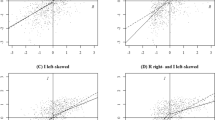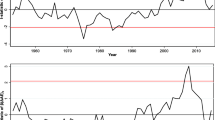Abstract
This study addresses simultaneity bias in piecewise linear forms of the earnings-return relation. We specify an overidentified system of simultaneous equations that incorporates both asymmetric earnings timeliness and asymmetric earnings persistence specifications and implement two-stage least squares for this piecewise linear system. Estimation of a system that is piecewise linear in endogenous variables presents several issues that are unprecedented in the accounting literature. Findings provide evidence that the asymmetric timeliness specification is particularly affected by simultaneity and that failing to correct for simultaneity results in coefficient estimates that potentially understate the degree of asymmetric earnings timeliness. Moreover, inferences regarding how conditional conservatism has evolved over time are sensitive to whether OLS or 2SLS coefficients are used as the basis of comparison.
Similar content being viewed by others
Notes
Other studies raise concerns about measuring conditional conservatism using coefficients from the piecewise linear earnings-on-return model that are not directly related to endogeneity (e.g., Givoly et al. 2007; Patatoukas and Thomas 2011). The extent to which these other concerns remain after consideration of simultaneity is beyond the scope of our study.
For ease of exposition, throughout we use the same notation for coefficients and error terms in the OLS and corresponding 2SLS equations. In all likelihood, they differ. Throughout the paper, variable subscripts i and t refer to firm i and fiscal year t, respectively.
We thank an anonymous referee for pointing out that inclusion of exogenous variables in the second-stage equations, as is done in Beaver et al. (1997), is econometrically unnecessary for the purpose of identification. As long as the number of excluded instruments from an equation meets or exceeds the number of endogenous variables in the equation, identification is achieved. This point applies both to the linear and piecewise linear systems.
Because R and X are endogenous, their indicator and interaction functions are endogenous by definition.
Please refer to Wooldridge (2002, pp. 235–237).
We estimate ERM, SMB, and HML firm-year coefficients using daily CRSP returns and daily factor returns from http://mba.tuck.dartmouth.edu/pages/faculty/ken.french/data_library.html.
Following Lev and Sougiannis (1996), we require at least four other firms in the two-digit SIC group.
We assign the percentage change in dividends variable, PCDPS, a value of zero for those firm-years wherein a firm did not pay dividends in both the current and prior year.
Also, refer to http://www.stata.com/support/faqs/stat/2sls.html for additional discussion concerning the lack of statistical meaning of R 2 in the context of 2SLS.
Larcker and Rusticus (2010) point out the importance of the over-identifying restrictions test before conducting the Hausman (1978) test for endogeneity. The over-identifying restrictions test is a test of the joint null that the instruments used in the first-stage regression are exogenous and that the exclusion restriction is appropriate (i.e., appropriate omission of the instruments from the second-stage equation). Untabulated findings indicate joint rejection of the null. However, additional untabulated findings from specifications in which we include 13 of our 15 exogenous variables in the second-stage model indicate the null cannot be rejected at the 0.05 level. This latter finding suggests that the rejection of the null in which all fifteen instruments are excluded is attributable to our exclusion restrictions rather than lack of exogeneity of the instruments.
We do not specifically discuss estimated coefficients from the first-stage models. In general, inferences are similar across the 1963–1990 and 1963–2008 sample periods.
We do not consider a partial R 2 or partial F-test, as we do not have non-instrument control variables in our system.
The similarity in first-stage model fit between the linear and piecewise linear specifications for return and earnings is expected. The instrumentation across specifications differs only by the four additional instruments from Eq. (11a), the primary role of which is to facilitate instrumentation of the indicator and interaction functions of return and earnings in the piecewise linear specification. Accordingly, these additional four variables have little effect on the instrumentation of return and earnings themselves.
The forbidden regression approach also involves estimating fitted values for return and earnings using Eqs. (7) and (8), rather than Eqs. (14b) and (15b), respectively. However, there is little effective difference in the resulting fitted values for return and earnings across these alternatives, as discussed in footnote 16.
References
Angrist, J., & Krueger, A. (2001). Instrumental variables and the search for identification: from supply and demand to natural experiments. Journal of Economic Perspectives, 15, 69–85.
Ball, R., Bushman, R., & Vasvari, F. (2008). The debt-contracting value of accounting information and loan syndicate structure. Journal of Accounting Research, 46, 247–288.
Ball, R., Sadka, G., & Sadka, R. (2009). Aggregate earnings and asset prices. Journal of Accounting Research, 47, 1097–1133.
Barth, M., Beaver, W., & Landsman, W. (1998). Relative valuation roles of equity book value and net income as a function of financial health. Journal of Accounting and Economics, 25, 1–34.
Basu, S. (1997). The conservatism principle and the asymmetric timeliness of earnings. Journal of Accounting and Economics, 24, 3–37.
Beaver, W., Lambert, R., & Morse, D. (1980). The information content of security prices. Journal of Accounting and Economics, 2, 3–28.
Beaver, W., Lambert, R., & Ryan, S. (1987). The information content of security prices: A second look. Journal of Accounting and Economics, 9, 139–157.
Beaver, W., McAnally, M., & Stinson, C. (1997). The information content of earnings and prices: A simultaneous equations approach. Journal of Accounting and Economics, 23, 53–81.
Bushman, R., & Piotroski, J. (2006). Financial reporting incentives for conservative accounting: The influence of legal and political institutions. Journal of Accounting and Economics, 42, 107–148.
Cragg, J., & Donald, S. (1993). Testing identifiability and specification in instrumental variable models. Econometric Theory, 9, 222–240.
Dietrich, J., Muller, K., & Riedl, E. (2007). Asymmetric timeliness tests of accounting conservatism. Review of Accounting Studies, 12, 95–124.
Fama, E. (1991). Efficient capital markets: II. Journal of Finance, 46, 1575–1617.
Fama, E., & French, K. (1993). Common risk factors in the returns on stocks and bonds. Journal of Financial Economics, 33, 3–56.
Feltham, G., & Ohlson, J. (1995). Valuation and clean surplus accounting for operating and financial activities. Contemporary Accounting Research, 11, 689–731.
Francis, J., LaFond, R., Olsson, P., & Schipper, K. (2004). Costs of equity and earnings attributes. The Accounting Review, 79, 967–1010.
Givoly, D., & Hayn, C. (2000). The changing time-series properties of earnings, cash flows and accruals: Has financial reporting become more conservative? Journal of Accounting and Economics, 29, 287–320.
Givoly, D., Hayn, C., & Natarajan, A. (2007). Measuring reporting conservatism. The Accounting Review, 82, 65–106.
Godfrey, L. (1999). Instrument relevance in multivariate linear models. Review of Economics and Statistics, 81, 550–552.
Hanlon, M., Rajgopal, S., & Shevlin, T. (2003). Are executive stock options associated with future earnings? Journal of Accounting and Economics, 36, 3–43.
Hausman, J. (1978). Specification tests in econometrics. Econometrica, 46, 1251–1271.
Hayn, C. (1995). The information content of losses. Journal of Accounting and Economics, 20, 125–153.
Holthausen, R., & Watts, R. (2001). The relevance of the value-relevance literature for financial accounting standard setting. Journal of Accounting and Economics, 31, 3–75.
Johnson, S. (2003). Debt maturity and the effects of growth opportunities and liquidity risk on leverage. Review of Financial Studies, 16, 209–236.
Kelejian, H. (1971). Two-stage least squares and econometric systems linear in parameters but nonlinear in the endogenous variables. Journal of the American Statistical Association, 66, 373–374.
Kleibergen, F., & Paap, R. (2006). Generalized reduced rank tests using the singular value decomposition. Journal of Econometrics, 133, 97–126.
Larcker, D., & Rusticus, T. (2010). On the use of instrumental variables in accounting research. Journal of Accounting and Economics, 49, 186–205.
Lev, B., & Sougiannis, T. (1996). The capitalization, amortization, and value-relevance of R&D. Journal of Accounting and Economics, 21, 107–138.
Miller, M., & Modigliani, F. (1966). Some estimates of the cost of capital to the electric utility industry, 1954–1957. The American Economic Review, 56, 333–391.
Ohlson, J. (1995). Earnings, book values, and dividends in equity valuation. Contemporary Accounting Research, 11, 661–687.
Ou, J., & Penman, S. (1989). Financial statement analysis and the prediction of stock returns. Journal of Accounting and Economics, 11, 295–329.
Patatoukas, P., Thomas, J. (2011). More evidence of bias in the differential timeliness measure of conditional conservatism. The Accounting Review (Forthcoming).
Petersen, M. (2009). Estimating standard errors in finance panel data sets: Comparing approaches. Review of Financial Studies, 22, 435–480.
Pope, P., & Walker, M. (1999). International differences in the timeliness, conservatism, and classification of earnings. Journal of Accounting Research, 37, 53–87.
Stock, J., Wright, J., & Yogo, M. (2002). A survey of weak instruments and weak identification in generalized method of moments. Journal of Business and Economic Statistics, 20, 518–529.
Watts, R. (2003). Conservatism in accounting part I: Explanations and implications. Accounting Horizons, 17, 207–221.
White, H. (1980). A heteroskedasticity-consistent covariance matrix estimator and a direct test for heteroskedasticity. Econometrica, 48, 817–838.
Wilson, W. (2008). An empirical analysis of the decline in the information content of earnings following restatements. The Accounting Review, 83, 519–548.
Wooldridge, J. (2002). Econometric Analysis of Cross Section and Panel Data. Cambridge: The MIT Press.
Acknowledgments
We appreciate the helpful comments of Stephen Ryan (editor), two anonymous referees, John Abowd, Tom Mroz, Daniel Taylor, Tim Vogelsang, and seminar participants at the University of North Carolina at Chapel Hill. We acknowledge funding from the KPMG research fund at the University of North Carolina. Edward Owens gratefully acknowledges funding from the Deloitte Doctoral Fellowship.
Author information
Authors and Affiliations
Corresponding author
Appendix
Rights and permissions
About this article
Cite this article
Beaver, W.H., Landsman, W.R. & Owens, E.L. Asymmetry in earnings timeliness and persistence: a simultaneous equations approach. Rev Account Stud 17, 781–806 (2012). https://doi.org/10.1007/s11142-011-9174-3
Published:
Issue Date:
DOI: https://doi.org/10.1007/s11142-011-9174-3
Keywords
- Asymmetric timeliness
- Asymmetric persistence
- Simultaneity
- Earnings-return relation
- Accounting conservatism




